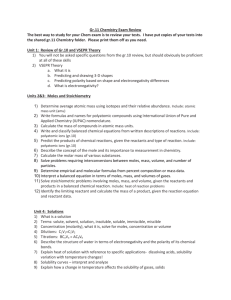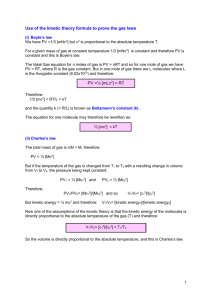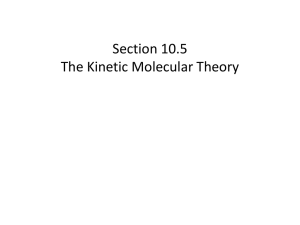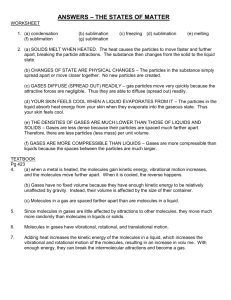Gas Law Learning Goals
advertisement
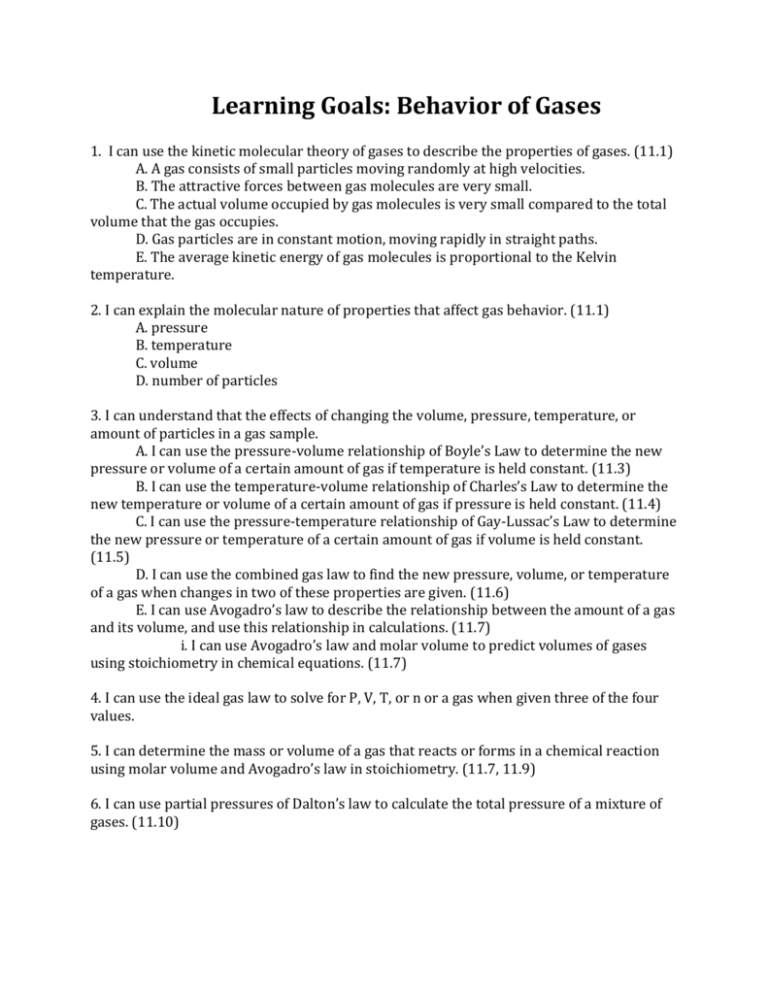
Learning Goals: Behavior of Gases 1. I can use the kinetic molecular theory of gases to describe the properties of gases. (11.1) A. A gas consists of small particles moving randomly at high velocities. B. The attractive forces between gas molecules are very small. C. The actual volume occupied by gas molecules is very small compared to the total volume that the gas occupies. D. Gas particles are in constant motion, moving rapidly in straight paths. E. The average kinetic energy of gas molecules is proportional to the Kelvin temperature. 2. I can explain the molecular nature of properties that affect gas behavior. (11.1) A. pressure B. temperature C. volume D. number of particles 3. I can understand that the effects of changing the volume, pressure, temperature, or amount of particles in a gas sample. A. I can use the pressure-volume relationship of Boyle’s Law to determine the new pressure or volume of a certain amount of gas if temperature is held constant. (11.3) B. I can use the temperature-volume relationship of Charles’s Law to determine the new temperature or volume of a certain amount of gas if pressure is held constant. (11.4) C. I can use the pressure-temperature relationship of Gay-Lussac’s Law to determine the new pressure or temperature of a certain amount of gas if volume is held constant. (11.5) D. I can use the combined gas law to find the new pressure, volume, or temperature of a gas when changes in two of these properties are given. (11.6) E. I can use Avogadro’s law to describe the relationship between the amount of a gas and its volume, and use this relationship in calculations. (11.7) i. I can use Avogadro’s law and molar volume to predict volumes of gases using stoichiometry in chemical equations. (11.7) 4. I can use the ideal gas law to solve for P, V, T, or n or a gas when given three of the four values. 5. I can determine the mass or volume of a gas that reacts or forms in a chemical reaction using molar volume and Avogadro’s law in stoichiometry. (11.7, 11.9) 6. I can use partial pressures of Dalton’s law to calculate the total pressure of a mixture of gases. (11.10) Vocabulary Gas Vapor Pressure Kinetic Molecular Theory of Gases Atmospheric Pressure STP Partial Pressure Achievement Scale Goal I can use the kinetic molecular theory of gases to describe the properties of gases. C Level I can list the five points of the kinetic molecular theory of gases. B Level I can explain the reasoning behind the five points in the kinetic molecular theory of gases. I can understand that the effects of changing the volume, pressure, temperature, or amount of particles in a gas sample. Given a change of one of the factors that affect gas behavior (amount, temperature, volume, and pressure), I can qualitatively predict the effect on another factor if all other variables are held constant. I can determine the mass or volume of a gas that reacts or forms in a chemical reaction using molar volume and Avogadro’s law in stoichiometry. Given a quantity in moles of reactant or product and a balanced chemical equation, I can use the mole ratio and molar volume to calculate the volume of gaseous reactants or products in the reaction. Given a change of one of the factors that affect gas behavior (amount, temperature, volume, and pressure), I can quantitatively use the gas laws to calculate the effect on another factor and explain why that effect occurs. Given the mass of a reactant or product and a balanced chemical equation, I can use molar mass, mole ratio, and molar volume or the ideal gas law to calculate the volume of gaseous reactants or products in the reaction. A Level I can explain the reasoning behind the kinetic molecular theory of gases and the reasons why these assumptions cannot be made for all of the states of matter. Given a change of multiple factors that affect gas behavior (amount, temperature, volume, and pressure), I can quantitatively use the combined gas law or the ideal gas law to calculate the effect on another factor explain why that effect occurs. Given the mass or gaseous volume of a reactant or product in an unbalanced chemical equation, I can use molar mass, mole ratio, and molar volume or the ideal gas law to calculate the gaseous volume of a reactant or product in the reaction in an unbalanced chemical equation. Sample Questions C Level 1) List the five points of the kinetic molecular theory of gases. 2) If the amount of moles of a gas is held constant with a fixed volume, predict the effect on the pressure of the gas if the temperature was doubled. 3) Given the following balanced chemical equation, N2(g) + O2(g) → 2NO(g), if 2 moles of nitrogen are reacted with an excess of oxygen, how many liters of NO can be produced at STP? B Level 4) Use the kinetic molecular theory of gases to explain why the volume of an inflated basketball is much greater than the actual volume of all of the air molecules themselves. 5) If the amount of moles of a gas are held constant with a fixed volume, what is the new pressure of the gas if initially, the gas is at STP and the temperature is increased to 30oC. Explain why the pressure increases in this way due to the change in temperature. 6) Given the following balanced chemical equation, N2(g) + O2(g) → 2NO(g), if 44.8L of nitrogen are reacted with an excess of oxygen, how many grams of NO can be produced at STP? A Level 7) Use the kinetic molecular theory of gases to explain why a bioterrorism attack using poisonous gas would be potentially much more difficult to control than an attack using liquid. 8) A 92.0g sample of a liquid is placed in a 25.0L flask. At 140oC the liquid evaporates completely to give a pressure or 0.900atm. What is the molar mass of the gas? 9) Given the following unbalanced chemical equation, C6H12O6(s) + O2(g) → CO2(g) + H2O(l), how many liters of CO2 gas can be produced if 30g of C6H12O6 are reacted in an excess of oxygen at a temperature of 25oC and a pressure of 850mmHg? Answers: 1) a. Gases are composed of molecules moving randomly at high velocities. b. Attractive forces in gases are very small. c. Actual volume of gas molecules is much smaller than the space that the gas occupies. d. Gas particles are in constant motion moving rapidly in straight paths. e. The average kinetic energy of gas particles is proportional to Kelvin temperature. 2) Pressure will also double. 3) 89.2L NO 4) The actual volume of the air molecules in a basketball is very small. However, due to the fact that the gas molecules are constantly moving at a very high velocity and that there are large amounts of space in between molecules, the gas exerts a pressure against the inside of the basketball. This pressure makes it inflate to a volume that is much greater than the actual volume of the molecules. 5) 1.11 atm or 844mmHg: As the temperature increases, the gas molecules move at a higher average kinetic energy. These higher speeds cause the gases to collide more often and thus, exert a higher pressure. 6) 120 g NO 7) Gases would pose a greater bioterrorism threat due to the fact that the gas particles travel randomly at extremely high speeds due to the kinetic molecular theory of gases. Through their repeated collisions, the gases spread out in all directions as they diffuse and are very difficult to both predict and contain. They have very little attractive forces that keep them together unlike liquids which have stronger intermolecular forces that keep them attracted to each other. Liquids also move much more slowly and do not occupy as large of a volume as a similar amount of gas molecules. For these reasons, it would be easier to contain a contaminated sample of liquid than a gas. 8) 138.6 g/mol 9) 21.9L O2


